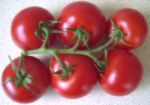Once you have had a taste of a home grown heirloom tomato you will never eat a store bought one again! Growing Heirloom Tomatoes can be tricky to grow so here are some tips.
I have found that starting them from seed indoors and then planting them outside at the proper time ensures the greatest success and volume of tomatoes. I've grown identical plants, but one from seed and one from a store bought plant. There was no comparison, the one grown from seed was stronger, healthier, produced more fruit and had less growing problems. Even though the store/nursery ones may look good, you never know how much stress they have been through. Stick with seeds if you can!
Even bugs know which tomatoes taste better. I have found that most tomato pests love heirlooms. Sure the hybrid plants may not suffer from some of the problems heirlooms do, but they don't have the taste or vigor either. Most heirloom tomato pests can be easily taken care of with a few simple steps.
Keep your plants clean, no loose fruits on the ground.
Make sure you stake your plants and tie them up well.
Pinch off any extra suckers, don't go overboard though.
Pick off any bugs, like tomato horn worm. If you see a huge weird moth around your plants get rid of that too, because most likely it is laying horn worm eggs. YUCK!
Heirlooms need consistant watering. If they go through too many periods of drought or overwatering they may crack. A good deep soaking is all that is necessary. Mulch your plants to keep the soil temperature more even and extend the growing season.
Plant marigolds and basil around your Heirlooms, they will ward off pests. Marigolds look adorable planted around tomatoes, and basil is a delicious companion plant for tomatoes.
Check out this website for free info on growing tomatoes and other veggies and tons of pictures! www.littlegardenpatch.com




